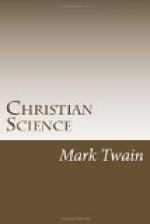With the above paragraphs compare these that follow. It is Mrs. Eddy writing—after a good long twenty years of pen-practice. Compare also with the alleged Poems already quoted. The prominent characteristic of the Poems is affectation, artificiality; their makeup is a complacent and pretentious outpour of false figures and fine writing, in the sophomoric style. The same qualities and the same style will be found, unchanged, unbettered, in these following paragraphs—after a lapse of more than fifty years, and after—as aforesaid—long literary training. The italics are mine:
1. “What plague spot or bacilli were [sic] gnawing [sic] at the heart of this metropolis . . . and bringing it [the heart] on bended knee? Why, it was an institute that had entered its vitals—that, among other things, taught games,” et cetera.—C.S. Journal, p. 670, article entitled “A Narrative—by Mary Baker G. Eddy.”
2. “Parks sprang up [sic] . . . electric-cars run [sic] merrily through several streets, concrete sidewalks and macadamized roads dotted [sic] the place,” et cetera.—Ibid.
3. “Shorn [sic] of its suburbs it had indeed little left to admire, save to [sic] such as fancy a skeleton above ground breathing [sic] slowly through a barren [sic] breast.”—Ibid.
This is not English—I mean, grown-up English. But it is fifteen-year-old English, and has not grown a month since the same mind produced the Poems. The standard of the Poems and of the plague-spot-and-bacilli effort is exactly the same. It is most strange that the same intellect that worded the simple and self-contained and clean-cut paragraph beginning with “How unreasonable is the belief,” should in the very same lustrum discharge upon the world such a verbal chaos as the utterance concerning that plague-spot or bacilli which were gnawing at the insides of the metropolis and bringing its heart on bended knee, thus exposing to the eye the rest of the skeleton breathing slowly through a barren breast.
The immense contrast between the legitimate English of Science and Health and the bastard English of Mrs. Eddy’s miscellaneous work, and between the maturity of the one diction and the juvenility of the other, suggests—compels—the question, Are there two guns? It would seem so. Is there a poor, foolish, old, scattering flint-lock for rabbit, and a long-range, centre-driving, up-to-date Mauser-magazine for elephant? It looks like it. For it is observable that in Science and Health (the elephant-ground) the practice was good at the start and has remained so, and that the practice in the miscellaneous, outside, small-game field was very bad at the start and was never less bad at any later time.
I wish to say that of Mrs. Eddy I am not requiring perfect English, but only good English. No one can write perfect English and keep it up through a stretch of ten chapters. It has never been done. It was approached in the “well of English undefiled”; it has been approached in Mrs. Eddy’s Annex to that Book; it has been approached in several English grammars; I have even approached it myself; but none of us has made port.




